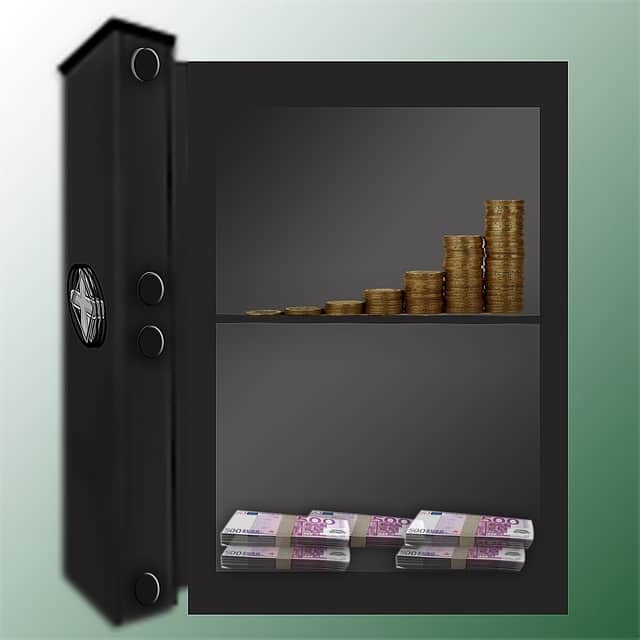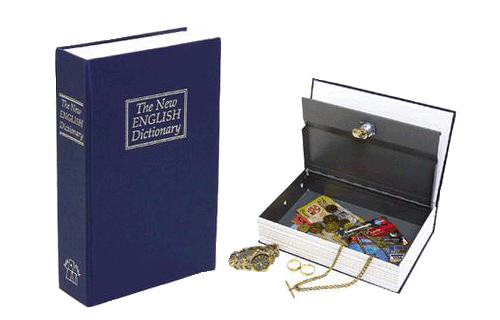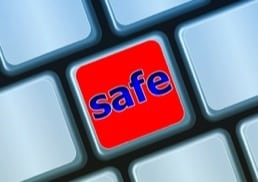Buying a Home Safe for Gold Silver Storage
There are many gold silver storage options available. From private vaulting and storage companies to “midnight gardening”. We go through the main ones in module 7 of our free Gold Ecourse: Module 7 of 8 – How and where to store it
A home safe is one storage option for precious metals and one that definitely fulfils the preference for keeping gold and silver “in your physical possession”.
So here are a few questions to consider before you buy a safe for your gold and silver.
8 Should Ask Questions Before You Buy a Safe to Store Gold & Silver
1. Why can’t I just use a “small safe” to store my gold and silver?
While you might think you only need a small safe as your precious metals take up very little space, the fact is, just the opposite is true.
A small safe will have thin walls made of low grade steel and will offer very little protection from attack. (Often referred to as a “tin box” due to the thin walls).
Watch this short video to show just how easy one of these “tin boxes” can be opened. It’ll make you think twice before leaving valuables in many hotel room safes! WARNING: The background music in the video is not exactly “soothing” so you might want to turn your volume down before it starts.
To offer a decent level of attack resistance a safe needs to be big and solid. It will require walls that are somewhere between 50 to 100mm thick or more. They’ll be made of steel with high performance concrete in between with steel reinforcing.
So you’ll be looking at something that is a hefty size to offer an appropriate level of attack resistance. It’s likely to be at least half a metre square.
It needs to be bulky enough that it can’t be easily carried away but ideally should be securely attached to the floor as well. Consider that when a safe is installed it’s trollied in by the installers so a thief could just as easily trolley it out if it wasn’t securely fixed to the floor.
Most burglars will spend very little time inside a house. They want to get in and get out. So a safe should be bolted and even glued to the floor. Of course this depends on what the floor is made from as to how the safe would be fixed. For a concrete floor a dynabolt is used to secure it.
2. Can I install a safe in an existing wall?
As just explained, a safe with decent attack resistance needs to be big and solid. So a small “box” that can be hidden in an existing wall just won’t offer any protection from attack. Here in New Zealand houses – unlike say Europe – have rather thin walls. So there aren’t too many options for fitting a safe into an existing wall.
So it’s more likely a false wall would need to be built to install a decent attack resistant safe in a wall discretely.
3. How can I discreetly install my safe?
While installing a safe into an existing wall may not be possible, there are various methods of keeping your safe “safe”.
Disguise your safe.
Perhaps build some furniture that will go over it. Or cover it with a blanket at the very least so it appears more like a piece of furniture.
Out of sight, out of mind.
Don’t advertise that you have a safe. It should be somewhere discreet where visitors, tradespeople and other house guests won’t see.
Then there are more intricate installations that will take more effort and cost.
Underneath a stairwell can be a good place. Take the door and surround off, install the safe and replace the surround and door. This will take some serious time to remove as well as being difficult to locate.
It really is down to your budget as to how innovative you can get.
Under-floor safes, where they are cemented into a floor, are – perhaps somewhat surprisingly – not recommended.
While you might think what you can’t see, you can’t find, the insurance industry actually only offer low insurable cover for these types of safe. They are actually not as “safe” or as user friendly as a freestanding safe bolted to the floor.
4. Do I need attack resistance or fire rating to protect my gold and silver?
For storage of gold and silver consider attack resistance first, fire rating is secondary, but a bonus if you can get it.
This is because fire resistant safes are built completely differently. Their walls are made out of light gauge steel with a “fibre mat” filler. Understand this is more about insulation from heat than attack resistance. They also have vents in the back to let heat escape. So all in all they are much easier to break into as they are built to withstand high temperatures not attack.
See this video that shows the internal composition of a fire safe and how it can be sawn through!
However many attack resistant safes will still provide some protection against fire even when they don’t have a fire rating. There is historical evidence whereby money held inside safes have survived fires in commercial buildings here in New Zealand.
5. What are relockers?
As already mentioned a quality attack resistant safe will have “meaty” steel walls filled with high MPA concrete. Also a solid composite door, likely to be made of predominantly the same material as the body of the safe.
But they may also offer another level of resistance in the form of “relockers”. So when a safe is attacked it will fire the relocker as another protective measure.
6. What is the “cash rating” on a safe and how does this apply to gold and silver bullion?

What is a “Cash Rating”? (Image source.)
A Cash Rating is for Insurance purposes. It refers to the level of cover that a particular safe is rated for in terms of cash contents. However for precious metals this value could potentially be doubled. For example, a $100,000 cash rating could be doubled to $200,000 for gold and silver bullion.
To achieve this the insurer will require a certified safe. For example to CEN (European) standard or AS/NZS 3809 standard. The harder it is to break into and the longer it takes, the higher the grade.
But it will also depend upon the installation and other measures in place such as security systems, cameras, fencing, gating etc.
In New Zealand insurance cover for gold and silver bullion can come via Lloyds of London so you will require a specialist insurance agent to get you cover for this. Don’t expect your home and contents insurance policy to cover it very easily.
7. Can I increase the “cash rating” if my silver and gold rises in value?
It pays to plan ahead in case your gold and silver end up being worth more than your safes cash rating a few years down the track (potentially a good problem to have though!).
So don’t just ask yourself what is the expected total value of your precious metals purchases. But also consider and allow for if they “go up in value” in dollar terms.
You should allow some leeway for this as the only way to increase the cash rating is to purchase a different safe with a higher cash rating, or purchase a second safe. Although some people do like to spread their load across more than one safe anyway.
8. Can’t I just buy a 2nd hand safe online to store some gold and silver?
It might cost only a few hundred dollars for a 2nd hand safe online. But what seems like a cheap safe, can have some potentially expensive hidden risks.
With a 2nd hand safe you don’t know its life and history. How has it been treated? Has it ever been breached? Has it been serviced regularly or at all?
Also there have even been instances where people have bought a 2nd hand safe online, only to find they don’t know the code! It could then cost $1500 to get a technician to access it. Due to transport costs to get it to the technician, the time it takes to then access it, and other factors like how many drill bits they go through accessing it. Then on top of this is repairing the safe so that it looks like it’s never been breached.
So like many things in life the cheapest option is often not the best.
Final Thoughts
One of the biggest misconceptions when it comes to safes, is that you can get a “tin box” and simply hide it in the wall. As discussed already these simply do not provide anywhere near the level of protection required. You’d be better off just hiding your bullion somewhere than using one of these.
There are a whole host of options when it comes to safes. On average between $1500 to $5000. What you need depends on the dollar value of the gold and silver bullion and therefore the cash rating, the volume it takes up (obviously a larger safe is required for bars of silver), and how and where it will be installed.
We’d need to know more details to give you any specific thoughts. However given we won’t be involved in what you decide, it’s best you share what you’re requiring with as few people as possible – for obvious reasons! And frankly we are in the business of selling gold and silver and so we’d prefer not to know what you do with it after you’ve bought from us.
So you should talk to an expert first that can advise you on the above along with transporting it to you and thoughts on insurance too if required.
We know an expert company with over 30 years experience in the New Zealand safe industry and so would be happy to connect you with them if you like. Read on for their details and what sets them apart.
Or if you prefer phone us on 0800 888 465 and just ask about our preferred supplier of safes.
Here’s why you should use our preferred safe supplier:
- They have been in business for over 30 years so have a trusted name and top reputation.
- They can supply top quality imported safes, but are also manufacture niche products as well.
- They are the only safe manufacturer in New Zealand that can design and manufacture custom product that complies with the exacting AS/NZS3809 Standards as well as European and US grading standards.
- They are a member of the NZ Security Association and adhere strictly to their code of ethics.
- They will organise delivery and installation of your safe nationwide.
- They offer a complete range of safe related services including:
- Fault Service (24hours x 7days)
- Safe Lock Outs (24hours x 7days)
- Combination Changes
- Preventative Maintenance
- Rekeying
- Lost/extra keys
- Refurbishment of existing safes
- Delivery/Relocation
- Disposal
 Special Gold Survival Guide Client Only Offer:
Special Gold Survival Guide Client Only Offer:
Free Bonus Book Safe
If you choose to purchase a safe from our preferred safe supplier, you’ll also get a free “Diversion Dictionary Safe” valued at up to $69 if you mention you were referred by GoldSurvivalGuide.
These are perfect to use as a “diversion” from your real safe. You can keep a few valuables, and some cash where it wouldn’t be the end of the world if you lost it. Then these act as a “diversion” for any would be thieves. They appear to be a book from the outside but have a hidden compartment inside them.
Hide Your Valuables in Plain Sight
- This Home Diversion Book Safe looks like a real dictionary.
- Place it on a book shelf and it will blend right in with the rest of your books.
- Hide valuables and important documents where thieves won’t think to look.
- Contains a metal safe with a key lock.
How to Claim Your FREE Dictionary Safe
Simple. Contact Challenger Safes on 0800 92 22 22 or email: info@challengersafes.co.nz and mention GoldSurvivalGuide sent you. Then to claim your free Dictionary Safe, just email us back at orders@goldsurvivalguide.co.nz once you have purchased your safe and let us know where to send it free of charge.
Related Articles
NZ Safety Deposit Boxes for Gold and Silver Storage
Buying gold or silver and wondering where to safely store it in New Zealand? ***** See the full details on our website here: NZ Safety Deposit Box Service for Gold and Silver StorageCan You Get Insurance on Gold and Silver Bullion in New Zealand?
The short answer to this question is “Yes”. However it’s not as simple as that. Check out this post for full details: Can You Get Insurance on Gold and Silver Bullion in New Zealand?Why is the Gold/Silver Ratio at New Highs?
Get all the details on the Gold silver ratio here: Gold Silver Ratio: Is Silver Undervalued Again?What is the spot price of gold or silver?
Here are all the details on this: What Does Gold Spot Price (Or Silver Spot Price) Mean? Or you can track the NZ dollar gold and silver price on our live charts and prices page. Plus there’s also historical charts of both on there too.What percentage of gold vs silver should I buy?
What percentage of gold vs silver should I have? This really comes down to individual preference. We see people who either buy all gold, all silver, or a mixture of both in varying amounts. We’ve actually written two separate articles outlining some ...


